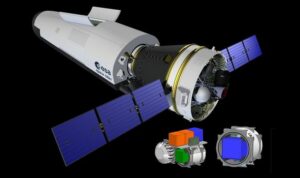Recently, we presented SAB Aerospace´s project IOSLAB, the In-Orbit Servicing LABoratory. IOSLAB is a standardized reusable modular facility to provide pressurized or unpressurized laboratory environment for different experiments in microgravity onboard the Space Rider missions. SAB intends to become a sub-aggregator offering the facility for In-Orbit Demonstration (IOD) for biological and electronics experiments for commercial clients or academia. We bring to you the description of the on board laboratory experiments being designed.
Today, we will unveil the MAiO – Micro-Algae in Orbit experiment which SAB Aerospace is preparing for the Mendel University in Brno, Czech Republic.
MAiO
MAiO is focused on microalgae experiments in microgravity and radiation. Microalgae is intended to be used for on-board production of cellular food supplements, remediation of air, fluids, production of oxygen, etc. and more applications during space travels.
IOSLAB – Pressurized facility design
The purpose of the experiment, in brief, is to obtain basic information about the systems biology (transcriptomics, metabolomics, proteomics, and epigenomics) of microalgae exposed to microgravity conditions and cosmic radiation. Total RNAseq transcriptome, including small RNAs, epigenetic tags, and selected metabolites, which have a fundamental effect on the modulation, adaptation of unicellular algal cells to abiotic stress niches.
The aim is to ensure the cultivation, survival, and reproduction of microalgae and, after Space Rider landing, to remove microalgae and perform a comprehensive analysis.
Based on the previous experiments and tests, Chlorella vulgaris microalgae was selected. In the case of successful cultivation in conditions of microgravity and increased radiation exposure, successful landing and collection of flight samples, an unprecedented amount of biological data will be obtained. Even data from a single successful experiment make it possible to obtain a large amount of information about the behavior of the cells used in microgravity.
In case of success or functionality, the system will be in fact a micro bioreactor for use on Multiple Space missions.
The objectives of the MAiO experiment are:
– Development and testing (TRL 9) of a small bioreactor for microalgae for long-term on-orbit experiments – verification of design and technology.
– Research of the influence of long-term microalgae cultivation in conditions of microgravity and increased flow of energy radiation on the metabolomics and genomics of microalgae with the aim to verify the possibility of the long-term cultivation influence on genome stability.
– The bioreactor is intended for small satellite missions. It is a 2U modular system, inspired by the CubeSats modular units. The developed prototype uses pressure and temperature controlled environment of the IOSLAB box. The design is cost-effective.
– Testing of a new principle of the culture solution parameters monitoring in a bioreactor in orbit conditions
Space Rider represents the possibility of returning samples under acceptable conditions back to Earth and the possibility of studying microalgae after exposure to conditions of microgravity and increased intensity of energy radiation in on-ground laboratories.
The experimental microbioreactor device will create the necessary conditions for the long-term cultivation of microalgae in limited volume conditions of about 65 cm3 per system.
The 2U experiment includes:
– Two independent microbioreactor systems, each of which consists of two cultivation microcuvettes, LEDs lighting and a set of sensors for temperature and lighting intensity;
– Each of the two closed systems is equipped with a membrane pump, which ensures the circulation of the medium thus prevents the cells settling and minimizes the negative effects such as clogging of the system, death of cells, etc.;
– A spectrophotometer for the microalgae conditions determining (especially chlorophyll content);
– All systems are controlled by their own on-board computer (DPU), which controls the experiment, reads all sensor data, controls the microbioreactor environment and analysis operations such as pumps switching off and on, spectrophotometers connections, measurements reading, etc..
The microalgae will be cultivated in a suitable medium that will not be refreshed throughout the whole flight.
Next time we will introduce you to the further IOSLAB experiments:
Nanobots – a biochemical experiment in microgravity, observing nanobots, which are used in medicine, drug delivery and other applications.
VESNA – an open-space experiment which will test a spectral camera designed for analysis of meteor ablation plasma and for recording of trajectories of meteoroids passing through the Earth´s atmosphere.

